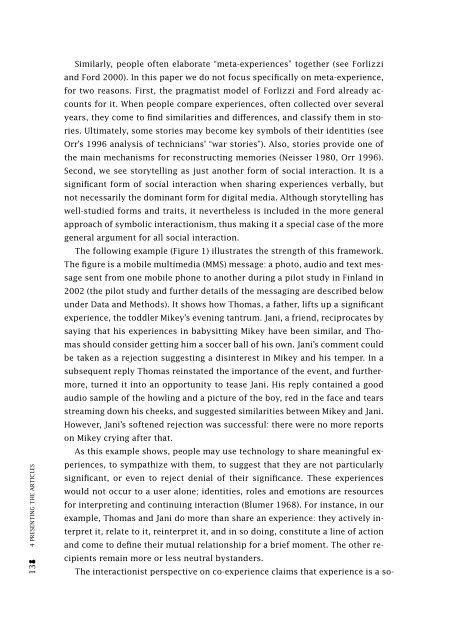Co-experience: Understanding user experiences in social interaction
Co-experience: Understanding user experiences in social interaction
Co-experience: Understanding user experiences in social interaction
You also want an ePaper? Increase the reach of your titles
YUMPU automatically turns print PDFs into web optimized ePapers that Google loves.
138 4 PRESENTING THE ARTICLES<br />
Similarly, people often elaborate “meta-<strong>experience</strong>s” together (see Forlizzi<br />
and Ford 2000). In this paper we do not focus specifically on meta-<strong>experience</strong>,<br />
for two reasons. First, the pragmatist model of Forlizzi and Ford already accounts<br />
for it. When people compare <strong>experience</strong>s, often collected over several<br />
years, they come to f<strong>in</strong>d similarities and differences, and classify them <strong>in</strong> stories.<br />
Ultimately, some stories may become key symbols of their identities (see<br />
Orr’s 1996 analysis of technicians’ “war stories”). Also, stories provide one of<br />
the ma<strong>in</strong> mechanisms for reconstruct<strong>in</strong>g memories (Neisser 1980, Orr 1996).<br />
Second, we see storytell<strong>in</strong>g as just another form of <strong>social</strong> <strong>in</strong>teraction. It is a<br />
significant form of <strong>social</strong> <strong>in</strong>teraction when shar<strong>in</strong>g <strong>experience</strong>s verbally, but<br />
not necessarily the dom<strong>in</strong>ant form for digital media. Although storytell<strong>in</strong>g has<br />
well-studied forms and traits, it nevertheless is <strong>in</strong>cluded <strong>in</strong> the more general<br />
approach of symbolic <strong>in</strong>teractionism, thus mak<strong>in</strong>g it a special case of the more<br />
general argument for all <strong>social</strong> <strong>in</strong>teraction.<br />
The follow<strong>in</strong>g example (Figure 1) illustrates the strength of this framework.<br />
The figure is a mobile multimedia (MMS) message: a photo, audio and text message<br />
sent from one mobile phone to another dur<strong>in</strong>g a pilot study <strong>in</strong> F<strong>in</strong>land <strong>in</strong><br />
2002 (the pilot study and further details of the messag<strong>in</strong>g are described below<br />
under Data and Methods). It shows how Thomas, a father, lifts up a significant<br />
<strong>experience</strong>, the toddler Mikey’s even<strong>in</strong>g tantrum. Jani, a friend, reciprocates by<br />
say<strong>in</strong>g that his <strong>experience</strong>s <strong>in</strong> babysitt<strong>in</strong>g Mikey have been similar, and Thomas<br />
should consider gett<strong>in</strong>g him a soccer ball of his own. Jani’s comment could<br />
be taken as a rejection suggest<strong>in</strong>g a dis<strong>in</strong>terest <strong>in</strong> Mikey and his temper. In a<br />
subsequent reply Thomas re<strong>in</strong>stated the importance of the event, and furthermore,<br />
turned it <strong>in</strong>to an opportunity to tease Jani. His reply conta<strong>in</strong>ed a good<br />
audio sample of the howl<strong>in</strong>g and a picture of the boy, red <strong>in</strong> the face and tears<br />
stream<strong>in</strong>g down his cheeks, and suggested similarities between Mikey and Jani.<br />
However, Jani’s softened rejection was successful: there were no more reports<br />
on Mikey cry<strong>in</strong>g after that.<br />
As this example shows, people may use technology to share mean<strong>in</strong>gful <strong>experience</strong>s,<br />
to sympathize with them, to suggest that they are not particularly<br />
significant, or even to reject denial of their significance. These <strong>experience</strong>s<br />
would not occur to a <strong>user</strong> alone; identities, roles and emotions are resources<br />
for <strong>in</strong>terpret<strong>in</strong>g and cont<strong>in</strong>u<strong>in</strong>g <strong>in</strong>teraction (Blumer 1968). For <strong>in</strong>stance, <strong>in</strong> our<br />
example, Thomas and Jani do more than share an <strong>experience</strong>: they actively <strong>in</strong>terpret<br />
it, relate to it, re<strong>in</strong>terpret it, and <strong>in</strong> so do<strong>in</strong>g, constitute a l<strong>in</strong>e of action<br />
and come to def<strong>in</strong>e their mutual relationship for a brief moment. The other recipients<br />
rema<strong>in</strong> more or less neutral bystanders.<br />
The <strong>in</strong>teractionist perspective on co-<strong>experience</strong> claims that <strong>experience</strong> is a so-

















